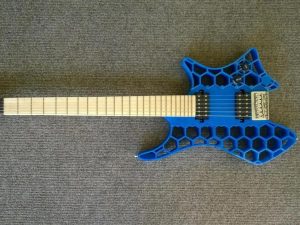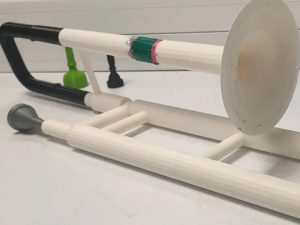Across all cultures, we make music. Mankind has found hundreds of ways to make music through the millennia, now it’s your chance to recreate some of those methods or create your own. We want to see functional designs of brass, string, woodwind, or percussion instruments. We’ve seen some great examples of what is possible with 3D-printed instruments in the past, we have high hopes for what you all can create this time.
All valid entries should be able to be played and make a noise. We don’t want to see toys that look like instruments but don’t play. We also don’t want to see accessories that don’t affect the sound of an instrument such as guitar stands or drumstick cases. Accessories that do affect the sound such as a mute for a trombone are also valid. Bellow you will find examples of instruments already uploaded to Printables to help inspire you.
Our very own Mikolas Zuza recently designed his own 3D printable electric guitar and we delayed this contest so he could get it done and no one would steel his thunder. Check out the Prusacaster if you want to see a great example of what is possible.
Making high quality printable instruments that actually sound good is going to be a challenge but we believe you all are up to it. To help ensure success, this contest will run for two months ending at the end of May. Good luck to you all and we can’t wait to see and hear what you all come up with!
 Concert Ukulele Concert Ukulele |
 |
 Touille V1.0 Touille V1.0 |
|
 Ergonomic Guitar Ergonomic Guitar |
 Duduk in C Duduk in C |
 The Recorder Flute The Recorder Flute |
 Kudu Horn Kudu Horn |
Prizes
Our first-place winner will receive a brand new Original Prusa i3 MK3S+ Kit.
The second-place winner will receive 3 spools of PLA or PETG Prusament or 1050 PrusaMeters.
 Third place will win a 2 spools of PLA or PETG Prusament or 700 PrusaMeters.
Third place will win a 2 spools of PLA or PETG Prusament or 700 PrusaMeters.

You all have a chance to help award some prizes too. We want to see your makes of these designs and the five entries with the most makes (who are not also main prize winners) will each receive 350 Prusameters good for filament and other awesome prizes.
Judging Criteria
- Overall quality of the model.
- Printability – Whether the model has an optimal orientation, whether it is divided into multiple parts so it can be printed more easily (without supports) etc.
- Originality – If you create something truly unique, it will be rated better than a slightly altered existing model.
- Popularity – Share your model to increase its popularity, and prove that users appreciate such a model.
- Your other works – In case we can’t decide between two favorite designs, we often check your other models to see what you can do.
- Assembly instructions – If your model consists of multiple parts, we check how easy it is to assemble the final product.
- Photo quality – Well-lit, in focus, and clear photos help show off your work and help us pick the best designs.
How to participate?
It’s easy to participate in this competition. Just follow these simple instructions.
- Design and create a model or improve an already existing one (“remix”) so that the result fits the theme of this contest. The model has to be printable on an FFF/FDM or SLA 3D printer (any manufacturer and model). This also means that you don’t need to own a 3D printer to participate. When creating the model, keep in mind the pros and cons of various types of 3D printing technologies and what can and can’t be actually done.
- Upload the model to Printables.com and make sure it contains:
- Model in .3MF or .STL file format (print files are optional)
- Photo or render of the model (ideally both)
- Model description
- Add the model to the contest. You will find the new competition button just bellow the download button on the print’s page after you publish your print. Click the Compete medal and select the “Musical Instruments” contest. After that, your print will be shown on the contest page and you will be in the running.
Of course, you can share your model on social networks (Facebook, Instagram, Twitter, Pinterest,…), and don’t forget to add @printablescom. This can help increase the popularity of the model.
Terms and conditions
- The contest runs from April 1st, 2023 to May 31st, 2023.
- You can submit any number of models (unique) to the competition and increase your chances of winning.
- Models submitted to the contest must be new models that have been uploaded on or after the 1st of February 2023.
- The model must contain at least one printed part.
- By entering the contest, you agree to keep your model posted to Printables.com for a minimum of one year. The Prusa team reserves the right to repost your design if it is removed before the end of that year.
- You must be the original creator of the model you upload, please no reposting other people’s models from other sites.
- We reserve the right to terminate the competition or change the conditions of the competition at any time. In case of violation of the terms and conditions or attempted fraud, the competitor will be disqualified.
- Submitting entries that do not fit the contest criteria will result in disqualification and repeated offenses may disqualify you from future contests.
- Results are at the judge’s discretion and all results are final.









Does the model have to produce sound by itself, or can the sound be produced electronically, so long as the instrument is fully playable?
The example of an electric guitar is one that’s a gray zone. It makes the sound itself, but it isn’t useful unless amplified.
But then there’s other stuff, like electronic pianos, organs, synthesizers, the theremin, and even versions of saxophones, clarinets, etc that are all electronic, but are fully playable and represent the original, non-electric version they are based on.
Does the model need to create sound without anyone else, or might the sound at any point be delivered electronically, insofar as the instrument is completely playable?
The case of an electric guitar is one that is a hazy situation. It makes the actual sound, yet it isn’t valuable except if intensified.
However at that point there’s other stuff, as electronic pianos, organs, synthesizers, the theremin, and even forms of saxophones, clarinets, and so on that are electronic, yet are completely playable and address the first, non-electric rendition they depend on.
In the <a href="https://www.spotifyguru.com/">Premium package</a>, all music, playlists, and everything in the app store are played at 320 kbps quality, without ads, ensuring the smoothest and most comfortable listening process.